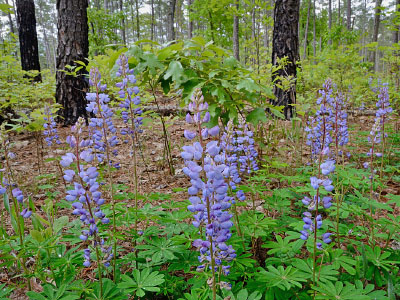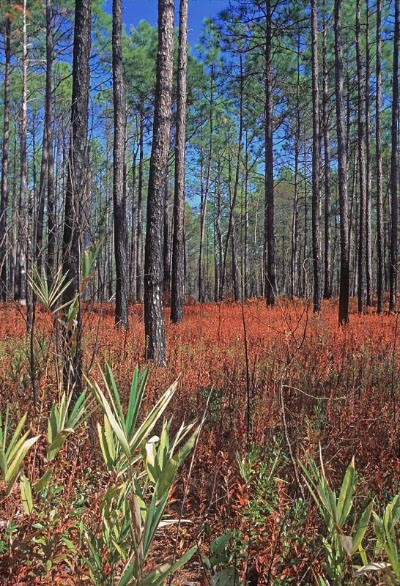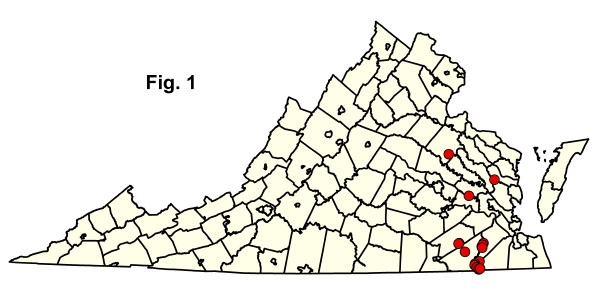
 Sở Bảo Tồn và Giải Trí
Sở Bảo Tồn và Giải Trí Bảo Tồn. Bảo Vệ. Tận Hưởng.
 Sở Bảo Tồn và Giải Trí
Sở Bảo Tồn và Giải Trí  Mục lục
Mục lụcRừng Sandhill và Fluvial Terrace
Nhóm này bao gồm thảm thực vật rừng có liên quan xuất hiện ở hai môi trường sống riêng biệt của Đồng bằng ven biển bên trong: trên các rặng núi (đồi cát) của các lưu vực sông cát ở đông nam Virginia; và trên các thềm cát cao tiếp giáp với sáu con sông ở đông nam và đông trung Virginia.
Sand ridges of the southeastern Virginia Coastal Plain support pyrophytic mixed woodlands of pines, scrub oaks, ericaceous shrubs, and light-demanding herbaceous xerophytes. Communities in this group reach their northern range limit in Virginia, where they occur in small, highly localized patches. Similar vegetation ranges through the southeastern Coastal Plain to Texas, and was likely much more widespread in southeastern Virginia prior to European settlement. Today, remnant habitats are located primarily on slightly elevated sand deposits stretching along the eastern sides of the Blackwater and Nottoway Rivers in Sussex, Southampton, and Isle of Wight Counties and the City of Suffolk. Soils are coarse xeric sands, often overlying clay-rich subsoils that may perch water briefly and limit rooting depths. The original vegetation of these sites is presumed to have been composed of open overstories of longleaf pine (Pinus palustris), perhaps in mixtures with pond pine (Pinus serotina) and loblolly pine (Pinus taeda) at the northern end of its range, with open understories of scrub oaks (Quercus spp.), patchy ericads, and areas of open sand with sparse herbaceous cover. Stand structure and successful reproduction of longleaf pine were presumably controlled by a natural regime of frequent low-intensity fires. Extant examples have been altered by heavy cutting and decades of fire exclusion. Longleaf pine has been almost entirely replaced by loblolly pine (Pinus taeda), and most stands are now quite closed. Various combinations of turkey oak (Quercus laevis), sand post oak (Quercus margarettae), water oak (Quercus nigra), bluejack oak (Quercus incana), southern red oak (Quercus falcata), blackjack oak (Quercus marilandica var. marilandica), and sand hickory (Carya pallida) occur as overstory co-dominants and understory trees.
Ở những địa điểm cao và khô cằn nhất, các loại cây bụi thường gặp bao gồm cây sồi độc (Toxicodendron pubescens), cây việt quất đen (Vaccinium arboreum), cây mâm xôi đỏ (Vaccinium stamineum) và cây sim lùn (Morella pumila). Các loại cây chịu hạn thân thảo đặc trưng, có thể bị loại bỏ gần như hoàn toàn do tán cây khép lại và tích tụ lớp lá rụng dày, bao gồm cỏ xanh bạc (Andropogon ternarius), cỏ ba lá xoăn (Aristida lanosa), cỏ lược (Bulbostylis ciliatifolia và Bulbostylis coarctata), cỏ chuông giống cỏ (Cuthbertia graminea), cây tầm ma (Cnidoscolus stimulosus), cỏ ba lá thông (Desmodium strictum), cỏ đuôi cáo Mỹ (Euphorbia ipecacuanhae), cây đậu lupin (Lupinus perennis), cây hoa tháng mười (Polygonella polygama), cây lá gợn sóng (Tragia urens), và cây móng tay Baldwin (Paronychia baldwinii ssp. riparia).

Trên các bãi cát phẳng liên quan đến các đồi cát, đất có thể có mực nước ngầm theo mùa nhưng chủ yếu thoát nước tốt và khô ráo trong thời gian dài trong năm. Tại đây, những mảnh vỡ còn sót lại tốt nhất chủ yếu là các quần thể hỗn hợp thông lá dài, thông loblolly và thông ao, với một ít cây sồi Thổ Nhĩ Kỳ nằm rải rác ở tầng dưới. Các lớp cây bụi rậm rạp, chủ yếu là cây thạch nam gồm nguyệt quế cừu (Kalmia angustifolia) hoặc nguyệt quế Carolina (Kalmia carolina), việt quất đen (Gaylussacia frondosa, Gaylussacia dumosa và Gaylussacia baccata), cây bụi rậm (Lyonia mariana), cây việt quất đen nhỏ (Vaccinium tenellum), cây việt quất leo (Vaccinium crassifolium), cây mâm xôi đen (Ilex glabra), cây cơm cháy Canada (Amelanchier canadensis) và cây mía (Arundinaria tecta)) là đặc trưng. Các loại thảo mộc thường thưa thớt, nhưng bao gồm dương xỉ miền Nam (Pteridium aquilinum ssp. pseudocaudatum), rêu pyxie thông thường (Pyxidanthera barbulata), cây họ đậu (Carphephorus bellidifolius và Carphephorus tomentosus), và cây cỏ mỏ có quả hẹp hình chùm (Rhynchospora distans).
Woodlands of the fluvial settings comprise a somewhat enigmatic community type occurring on flat, sandy terraces and islands along Coastal Plain rivers in eastern Virginia. These habitats are elevated well above the level of adjacent swamps and are characterized by xeric, sandy soils and open forest or woodland vegetation. Single occurrences have been documented along the Nottoway River (Sussex County); Chickahominy River, Pamunkey River and Ware Creek (New Kent County); Dragon Swamp (Middlesex County); and Mattaponi River (Caroline County). At all six sites, hickories (Carya pallida and Carya tomentosa) are the dominant trees, with drought-tolerant oaks (Quercus falcata, Quercus nigra, Quercus marilandica var. marilandica, Quercus alba) and pines (Pinus taeda, Pinus virginiana) present in smaller numbers. Shrubs occurring at all or most sites include sand post oak (Quercus margarettae), common sweetleaf (Symplocos tinctoria), American holly (Ilex opaca var. opaca), farkleberry (Vaccinium arboreum), and eastern red cedar (Juniperus virginiana). Typical herbs include sedges (Carex albicans var. australis, Carex pensylvanica, and Carex tonsa), Canada frostweed (Crocanthemum canadense), butterfly pea (Clitoria mariana var. mariana), sandhill goldenrod (Solidago tarda), and prickly-pear (Opuntia humifusa). The Dragon Run site is anomalous in the presence (despite low soil pH and base status) of several calciphiles such as eastern redbud (Cercis canadensis var. canadensis), wild columbine (Aquilegia canadensis), smooth rock cress (Boechera laevigata), robin's-plantain (Erigeron pulchellus var. pulchellus), and elm-leaved goldenrod (Solidago ulmifolia). A full understanding of the status and compositional relationships of this group will require additional inventory and assessment.
Bất chấp những xáo trộn trong quá khứ và hiện tại, rừng cát và rừng bậc thang ven sông là những cộng đồng quan trọng đối với công tác bảo tồn và phục hồi ở Virginia vì tính hiếm có của chúng trong khu vực. Các ví dụ về rừng cát ở Virginia, cùng với các ví dụ ở đông bắc Bắc Carolina, không có cỏ dây (Aristida stricta và Aristida beyrichiana) và các loại cỏ chịu nhiệt khác đặc trưng của các cộng đồng tương tự ở xa hơn về phía nam và do đó được cho là đại diện cho một biến thể thành phần hiếm. Các khu vực tại Khu bảo tồn sinh thái Blackwater (gần Zuni, Quận Isle of Wight) và Khu bảo tồn thiên nhiên DCR Antioch Pines liền kề đang được quản lý bằng biện pháp đốt có kiểm soát, nhưng những khu vực còn lại đang rất cần được bảo vệ và phục hồi.
Tài liệu tham khảo: Frost và Musselman (1987), Plocher (1999).
Nhấp vào đây để xem thêm ảnh về nhóm cộng đồng sinh thái này.
 © DCR-DNH, Gary P. Fleming.
© DCR-DNH, Gary P. Fleming.

 Tải xuống bảng tính thống kê tóm tắt thành phần cho từng loại cộng đồng được liệt kê bên dưới.
Tải xuống bảng tính thống kê tóm tắt thành phần cho từng loại cộng đồng được liệt kê bên dưới.

